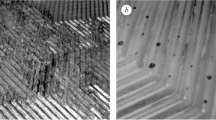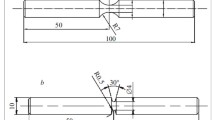Abstract
The reasons for fracture of fasteners made of 30KhGSA steel were analyzed. It was found that, in the case of fracture of bolts in the package connecting the frame elements, the damage of the bolts is the result of the fretting corrosion due to the mutual friction between bolts and elements of skin, belt, and tape. Fretting corrosion develops in the locations of the cadmium coating damage of bolts in the process of friction. The break-in scuffing of the openings and corrosive damage (fretting corrosion) triggering intergranular fracture, which is the most severe in the skin and tape, contribute to the fractures in the belt, skin, and tape. The reason for fracture is structural and technological factors: high stresses in the investigated package, micro-displacement of the mating parts, violation of the cadmium coating, insufficient protection against corrosion and environmental impact. Fracture of the self-locking nuts made of 30KhGSA steel with the anticorrosion cadmium coating used during assembly of an auxiliary gas turbine engine is induced by their severe overheating—the impact of the melted coating on the surface of the loaded nuts and penetration of the liquid metal into the base material along the grain boundaries. Application of the cadmium coating for the operation of the steel parts at a temperature exceeding (even for a short time) the melting temperature of Cd (Tmelt = 320.9°C) under the condition of contact with the stressed metal owing to the Rebinder effect leads to a dramatic loss of strength and premature failure of the part. Fracture of the galvanized bolts made of 30KhGSA steel was studied in the process of the repeated static testing. It was found that several factors contributed to the onset of the multiple fractures: rough scratch marks, sandblasting performed before galvanizing with the use of large sand fractions, dents which contribute to the premature origin of cracks, areas with deposits formed during coating with loose adhesion of the layer. The presence of a large number of pits along with the fatigue grooves indicates the operation of the material under high load. The investigation was carried out by the method of optical and scanning electron microscopy applying the X-ray microanalysis.










Similar content being viewed by others
REFERENCES
Muboyadzhyan, S.A., Konnova, V.I., Gorlov, D.S., and Aleksandrov, D.A., Fretting resistance of EP866Sh steel, Tr. Vseross. Nauchno-Issled. Inst. Aviats. Mater., 2015, no. 7, art. 1. https://doi.org/10.18577/2307-6046-2015-0-7-1-1. http://www.viam-works.ru. Accessed November 24, 2016.
Grigorenko, V.B., Orlov, M.R., Morozova, L.V., and Zhuravleva, P.L., Research of static destruction of bolts from steel 30KhGSA under operating conditions, Aviats. Mater. Tekhnol., 2014, no. 4, pp. 125–135. https://doi.org/10.18577/2071-9140-2014-0-s4-125-135
Istoriya aviatsionnogo materialovedeniya. VIAM—80 let: gody i lyudi (History of Aviation Materials Science. To the 80 Anniversary of the All-Russian Scientific Research Institute of Aviation Materials: Years and People), Kablov, E.N., Ed., Moscow: Vseross. Nauchno-Issled. Inst. Aviats. Mater., 2012.
Kablov, E.N., Materials and VIAM technologies for “Aircraft engine”, Inf. Byull., Permskie Aviats.Dvigateli, 2014, suppl., pp. 43–47.
Kablov, E.N., Innovative developments of the All-Russian Scientific Research Institute of Aviation Materials within the project “Strategic development of materials and technologies of their recycling until 2030,” Aviats. Mater. Tekhnol., 2015, no. 1, pp. 3–33. https://doi.org/10.18577/2071-9140-2015-0-1-3-33
Sorokin, V.G., et al., Stali i splavy. Marochnik: Spravochnoe izdanie (Grades of Steel and Alloys: Handbook), Sorokin, V.G. and Gervasyev, M.A., Eds., Moscow: Intermet Enzhiniring, 2001.
Kobayashi, J., Ina, D., Yoshikawa, N., and Sugimoto, K., Effects of the addition of Cr, Mo and Ni on the microstructure and retained austenite characteristics of 0.2% C–Si–Mn–Nb ultra-high-strength TRIP-aided bainitic ferrite steels, ISIJ Int., 2012, vol. 52, no. 10, pp. 1894–1901.
Samoilovich, Yu.A., Strengthening railroad rails by isothermal quenching to lower bainite, Metallurgist, 2013, vol. 56, nos. 9–10, pp. 779–786.
Nesterova, E.V., Zolotorevskii, N.Yu., Titovets, Yu.F., and Khlusova, E.I., Inheritance of misorientations and model of formation of bainite structure in low-doped steels under the influence of austenite deformation, Inorg. Mater.: Appl. Res., 2012, vol. 3, no. 6, pp. 517–523.
Orlov, M.R., Ospennikova, O.G., and Gromov, V.I., Thunders of mechanisms of hydrogen and beynitny fragility of constructional steel in use large-size designs, Aviats. Mater. Tekhnol., 2012, suppl., pp. 88–93.
Chabina, E.B., Alekseev, A.A., Filonova, E.V., and Lukina, E.A., Application of analytical microscopy and the x-ray analysis for analysis of structural and phase condition of materials, Tr. Vseross. Nauchno-Issled. Inst. Aviats. Mater., 2013, no. 5, art. 6. http://www.viam-works.ru. Accessed November 24, 2016.
Orlov, M.R., Grigorenko, V.B., Morozova, L.V., and Naprienko, S.A., Research of operational destructions of bearings by methods of optical, raster electronic microscopy and X-ray microanalysis, Tr. Vseross. Nauchno-Issled. Inst. Aviats. Mater., 2016, no. 1, art. 9. https://doi.org/10.18577/2307-6046-0-1-62-79. http://www.viam-works.ru. Accessed November 24, 2016.
Zhegina, I.P., Kotel’nikova, L.V., Grigorenko, V.B., and Zimina, Z.N., Features of destruction of deformable nickel alloys and steels, Aviats. Mater. Tekhnol., 2012, suppl., pp. 455–465.
Orlov, M.R., Ospennikova, O.G., and Gromov, V.I., The slowed-down destruction of steel 38KhN3MA in the course of long operation, Vestn. Mosk. Gos. Tekh. Univ. im. N.E. Baumana, Ser. Mashinostr., 2011, special issue, pp. 5–10.
Orlov, M.R., Fundamental study and qualifying of materials. Nondestructive testing, Aviats. Mater. Tekhnol., 2012, suppl., pp. 387–393.
Turchenkov, V.A., Baranov, D.E., Gagarin, M.V., and Shishkin, M.D., Methodical approach to carrying out examination of materials, Aviats. Mater. Tekhnol., 2012, no. 1, pp. 47–53.
ACKNOWLEDGMENTS
We express thanks to I.P. Zhehin and N.G. Pokrovskaya for the invaluable contribution to the investigations and shared experience.
Funding
This work was performed within the framework of the development of critical technology no. 21 “Technologies of Prevention and Emergency Management of the Natural and Technogenic Character” from the list of the Critical Technologies of the RF approved by the Edict of the President of the Russian Federation of June 7, 2011, no. 899.
Author information
Authors and Affiliations
Corresponding author
Additional information
Translated by E. Grishina
Rights and permissions
About this article
Cite this article
Grigorenko, V.B., Morozova, L.V. Fracturing Behavior of Metalware Made of 30KhGSA Steel. Inorg Mater 55, 1481–1489 (2019). https://doi.org/10.1134/S0020168519150081
Received:
Published:
Issue Date:
DOI: https://doi.org/10.1134/S0020168519150081




